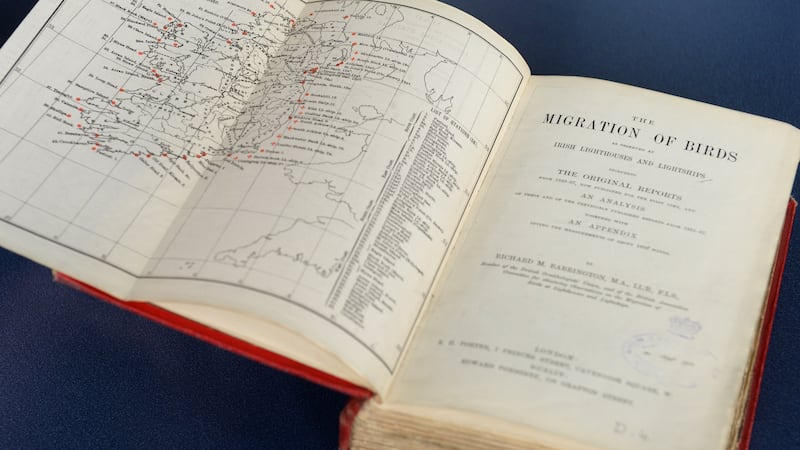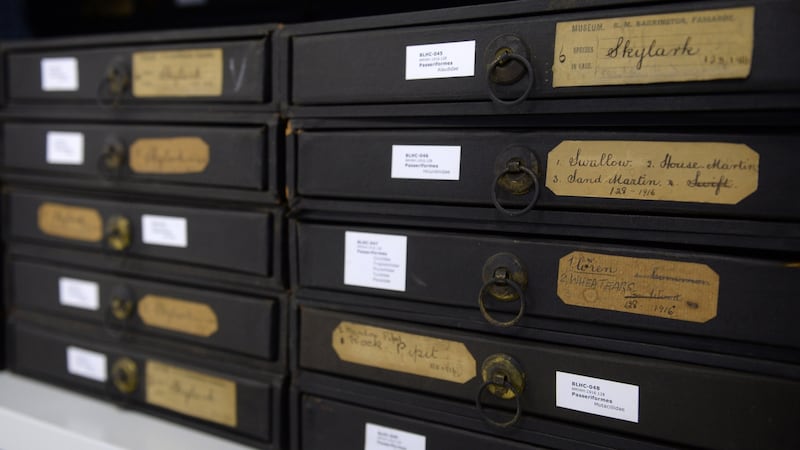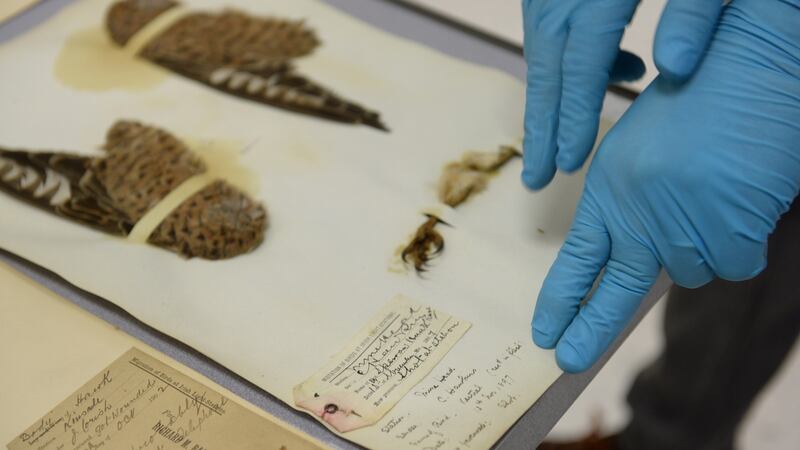“We are just around the corner from the bear. In the zoology cage,” Paolo Viscardi tells the receptionist at the National Museum’s Collections Resource Centre. Viscardi, Curator for Zoology at the Natural History Museum is instructing the receptionist where to bring my photographer colleague. We are at the centre near Swords; a vast former factory that now acts as a storage area for various items from our national museums.
There is indeed an upright bear close by us, not to mention a stuffed crocodile, buffalo heads, foxes, wolves, zebras, monkeys and very many entire birds, including a peacock in a large plastic bag. It's the birds I'm here for. Or rather, I'm here to examine some of the 3,000 wings and claws of birds held by the museum, as part of the extraordinary bequest made to it in 1916 by the amateur ornithologist, Richard Manliffe Barrington, who died the previous year.
In an era that predated air travel, one Victorian theory of where birds such as swifts and swallows went in the winter months was that they hibernated underwater
In the 21st century, it’s difficult to recall an era where we knew so little about bird migration routes and patterns. In an era that predated the mass mobility of people, long before air travel, one Victorian theory of where birds such as swifts and swallows went in the winter months was that they hibernated underwater.
Barrington was born in 1849, and lived at Fassaroe House, in Fassaroe, Co Wicklow. Although he was called to the bar, his true interest was in the natural sciences, and he had the financial means to indulge it. Birds were what fascinated him the most, particularly the mysteries of their flight paths.
In the late 19th century, there were 48 lighthouses and 10 lightships in existence around the coast of Ireland. Some of the more unfamiliar of these locations were at: Mew Island, Samphire Island, Spit Bank, Barrels Rock and Lucifer Shoals. These light stations were all manned. Barrington came up with an audacious idea; one that could only have been carried out by a man of independent financial needs. Birds are attracted to light, and lighthouse keepers frequently awoke in the mornings to find dead birds at the bottom of their lighthouses or lightships. “Killed striking” is the expression that was used to describe these bird deaths.
He came up with the idea of contacting all 58 of the light stations around Ireland, and asking the keepers to collaborate with him. He wanted to know if they would collect and identify the dead birds found at their various stations each morning, and send back specimens and details to him in Wicklow. The keepers said yes: there was a lot of in-between time in those frequently isolated postings.

Specimen boxes
Viscardi opens the doors of a filing cabinet in the Zoology Cage. It’s a filing cabinet of the kind you find in any office, the kind that usually contains paper for the photocopier, or boxes of pens and notebooks. This cabinet contains dozens of specially-made cardboard specimen boxes, each one marked with beautifully written faded labels. Kestrel. Swallow. Puffin. Snow Bunting. Blackbird. Song Thrush. Coot. Starling. Golden Plover. Lapwing.
There are many other specimen names. Between 1881 and 1897, the keepers sent pre-paid envelopes back to Barrington in Wicklow. Most contained legs and wings, together with details of where and when the bird had been found, how it had died, the name of the keeper, and the name of the bird.
Barrington had left information sheets with each keeper, with precise instructions. “It is to be hoped that the light keepers will not think it too much trouble to cut off and label the wing of every common bird which is killed at their station. Rare birds should be sent entire. Do not put more than one leg and wing in each envelope, and when several are full, forward the lot by post in a larger envelope. Rare or strange birds send entire.”
Viscardi opens one box of kestrel wings and legs, and one of skylarks. The bird specimens, two at most per piece of thick paper, are inserted into tiny openings made by paper cuts. The prepaid envelopes the bird specimens were sent in had integrated labels, which the keepers had completed and were then cut out by Barrington, who then pinned one to each sheet. The envelopes were collected from the keepers by Irish Lights relief ships, when dropping off supplies around the coast.
Barrington’s information sheet to the keepers included a “Recipe for preserving legs and wings.” They were to brush each specimen part with a solution made of spirits and corrosive sublimate; a type of mercury. For the rare and unknown birds, which were to be sent whole, he gave this advice, “If no boat comes, steep birds in methylated spirits. It does not injure them.” (He meant, of course, it doesn’t injure their preservation; the birds were already dead.)
“You can see where the birds were leaking oils,” Viscardi says, pointing to century-old stains on the paper. It is an incredibly visceral experience to look at these bird parts, collected so carefully by long-dead keepers of a profession now long redundant through automation. I also cannot stop thinking about the postman whose surreal task it was to deliver these hundreds and hundreds of envelopes containing wings, legs and claws to Fassaroe House. More than 3,000 of these specimens were sent to Barrington, along with a further 1,000 whole birds.
“Citizen science is just a new name for what people have been doing forever, effectively,” Viscardi explains. “It’s what Darwin did; talking to local people, collecting samples. It’s as old as science itself. It’s an early form of Big Data.”

Voluntary work
It wasn't just the dead birds Barrington was interested in. He also asked the keepers to record the kinds of live birds they saw, their rough numbers, and at what time of day and year they were observed. The keepers were not paid for their voluntary work; work which had received the imprimatur from the Commissioners of Irish Lights, provided it did not interfere with their primary duties. Some of the reports of how birds died that Viscanti shows me bluntly state "shot", such as the kestrel described as "shot at station" at Mine Head on February 3rd, 1897. "People used to like shooting stuff," he says laconically.
All of the labels and reports are hand-written, in careful black ink. Some keepers apparently wrote notes and letters to go in the envelopes with their bird parts. They had time to do so, and some at least, must have yearned for company and other forms of stimulation in their long, sometimes storm-bound postings. Barrington wasn’t interested in these invaluable documents of social history. He only cared about the bird samples, and few of these letters are known to have survived. I did not see any.
Few perhaps, can realise what the collection of statistics, the preparation, the printing and the publication of this book have cost in time and money…
For Barrington, the whole point of the exercise in collecting bird specimens from the light keepers was to try to analyse the results; to form patterns of where and when various birds appeared. He used the specimens sent to him in the 16-year period between 1881 and 1897 as the research material for his book, The Migration of Birds as Observed at Irish Lighthouses and Lightships. It was published in 1900.
There were only 350 copies of the book published. The National Library has one in its catalogue. I ordered it from storage and duly turned up on the appointed day to consult it in the Kildare Street Reading Room, whereupon the librarian informed me with embarrassment that “The book seems to have gone missing”.
Bequest
Fortunately, Viscardi was able to tell me that the Natural History Museum had acquired its own copy back in 1916, upon receiving the bequest from Barrington after his death. This copy is kept at the Museum’s Beggar’s Bush site, but he retrieved it from there, and brought it out to Swords so I could consult it there
The result of Richard Manliffe Barrington’s epic study of bird migration is a fat red hardback. Stamped in gold on the front cover is a tiny, beautiful image of a lighthouse with birds flying around it. Towards the beginning are copies of the forms and instructions he issued the keepers with, along with a pull-out map of Ireland and the locations of all the lighthouses and light ships. Much of the rest of the text is records and analysis of the findings of the bird specimens, as collected over the 16 years of the ad-hoc project.
In his introduction, Barrington writes with palpable feeling, “Few perhaps, can realise what the collection of statistics, the preparation, the printing and the publication of this book have cost in time and money…”
Much of the information is organised chronologically, and painstakingly broken down by species. The keepers were acknowledged by name in the book. Some wrote detailed notes about what they observed, and Barrington includes these notes, sometimes adding his own. One entry from 1894 refers to the chaffinch, as observed by keeper J. Higginbotham at Hook Tower. The weather had clearly been severe at the time.
“January 8th, during the past four days, chaffinches, greenfinches and grey linnet have been around here dying in hundreds. The skylarks appear better able to find something to eat, as I got none of them dead. I picked up over a dozen dead rock pipits. The starlings also died in scores. I got seven grey plover killed against glass (a rare bird to strike), and four lapwing. I fancy little importance can be attached to the direction the birds struck from on that night, as, owing to the quantity of snow that fell, the birds made for the sea-coast, where the snow soonest thaws, in thousands, and were in fields on the north side of station, and after our fog-gun was fired every 10 minutes, the birds rose and made circuits round tower and lantern, some of them striking and getting killed. The common crows and even the starlings were eating the dead birds…”

Pure gothic
There is something of the pure gothic in this description; the relentless accounting of so much death. I found myself wondering what meditating on the deaths of so many birds “killed striking” or starving, and then recording them, had done for the mental health of the isolated men who studied these birds.
The copy of The Migration of Birds that Viscanti shows me is noticeably battered. "It's a working copy," as he points out. This is the exact book generations of curators at the Natural History Museum have consulted over the decades. He points out various notes and pencil marks former curators have made. One in the 1920s has noted that some specimens that were logged as having arrived are in fact missing from the collection. "So when I was showing you the specimens just now, I saw a box with pieces of paper that had not been filed, and it's possible the missing ones are in there. That will be a nice curatorial job for sometime in the future," he says.
Although Barrington published his book in 1900, bird specimens continued to arrive at Fassaroe House for years afterwards. Even after his death in 1915, the wings and claws continued to arrive. “Collectors don’t stop because they’ve published a book,” Viscardi points out. “There’s always another book on the horizon.”
Along with the bird specimens, Barrington’s bequest also included more than a hundred taxidermy birds in display cases. While the specimens can only be seen on request for research purposes, everyone who has ever visited the Dead Zoo on Merrion Street, has seen part of Barrington’s bequest, whether they realised it or not. Some of these taxidermy birds are on display there, distinguished by the fact they are the only cases in the museum painted white. These are known as “Barrington’s Birds”; a hint at the extraordinary, mainly invisible, legacy of ornithology he left behind.











